My Favorite Girevoy Sport Assistance Exercises
Jared Savik, 2004 American GS National Champion
February 21, 2005 01:40 PM
When I ordered my first
kettlebell in January 2002 it was completely unfamiliar to me. I had never seen one used and certainly never hoisted one. I justified the kettlebell's expense by not paying gym dues for three months. I've not been a gym member since, although I did go once with my wife
and still pulled an easy 405# sumo deadlift without deadlifting for over a year. Thank you kettlebells!
A lot has transpired since that first 'bell. My wife bought me a 32kg for Christmas, I learned a lot from the
DD forum, did a ton of snatch & jerk ladders and I left a lot of digestive juices in the snow! The nearest RKC, over 200 miles away, decided to host a GS meet in the early 2004 and using my odd couple (the 24 and 32kg), I trained for this GS comp by the seat of my pants and a copy of Andrey's GS primer. My training paid off and I was able, to my astonishment, put up over 60 jerks and almost 50 snatches with the 24 kg 'bells in the 90kg class. Not too bad for no formal training!
I was encouraged to compete at Nationals, which I did and won my weight class and the "best lifter" award. Since then all my kettlebell training leans towards upping my Jerk and Snatch count.
Anyone who competes athletically knows that they cannot make great gains simply by practicing their event over and over. In every event, every competition, someone has a weak link limiting their performance. In order to improve their overall performance, these weak links must be improved. The weak link in the snatch is easy to find. For 99.9% of the competitive American gireviks, the weak link is the grip. The jerk is a different story due to its complexity. Predominately, the legs are the weak link because without strong, explosive leg power, the shoulders do a lot of the work and tire prematurely. Even with strong legs, the girevik needs strong shoulders and triceps. Heavy kettlebells (32kg) require a lot more upper body strength to achieve a solid lockout during extended sets.
In this last year, I've put a lot of thought into GS training and have come up with a training theory and several pet assistance exercises that address my weak links. Your weak links may be different, but I'd bet we are pretty similar.
First, a short note about my training theory. One cannot train exclusively (jerks and snatches) for GS year round. I break my training down into 3 periods: strength, endurance, and pre-comp, all using kettlebells. Each period is roughly six weeks long, but can be as long as two months. This may be covered in a later article.
Assistance exercises for the snatch can be described as Grip work, more grip work and some cardio! More specifically, the wrist roller, straight sets without switching hands, and drop sets.
The Wrist Roller: Buy a few feet of climbing rope, tie it off to the center of an old dumbbell handle and tape it. Roll up some rope before you begin to prevent it from twisting. You can tape the ends of the dumbbell if you like. Attach the other end of the rope to a small kettlebell or other weight. To use, simply grip tightly and roll the weight up, not as fast as you can, but as far as you can with each wrist rotation. Do it once forward, flip the bar around and once the other way. This works the both the front and the back of the forearm. To make it tougher, add weight or stand on a stool for extra distance. Although not a strength move, I prefer to do a few sets short of failure (GTG style) throughout the day during my strength and endurance phases.
Hand Roller: Sandwich and glue a small block of wood between two or four 2.5# weights. I've had good luck with Gorilla Glue. Attach & tie another rope to the center. Hold in front and rotate until weight reaches your hands. Release, flip the weights around and work in the other direction. Notice how much more it taxes your wrist and fingers than your forearm.
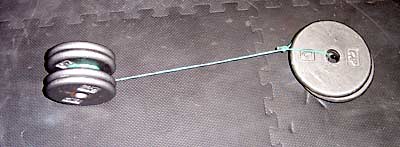
The hand rollerWhile the rollers are great assistance exercises, I'm finding that they do not replace quality snatches. As a competition nears, I do more and more snatches and less rollers. Currently, on snatch days I prefer to do all sets of snatches with one arm before switching to the other. By taking only one-minute breaks, I stay within the 80-90% intensity range, which is the most beneficial for endurance training. Another good method is drop set snatches if you have kettlebells of multiple weights. Simply do a near max set with your heaviest 'bell, quickly change to your next lighter bell and do more snatches until you are just a few reps short of grip failure and repeat down the line. This is an excellent way to increase forearm and cardio endurance! Just remember that this is not a relaxed competition pace so don't spend extra time at lockout. The drop set is pretty demanding, physically and psychologically, so I wouldn't attempt it more that once every week or two. Be sure to stretch your forearms when you are finished
My four favorite assistance exercises for the Jerk are squat jumps, offset pushups followed by military presses, walking lockouts, and dive-bomber pushups.
Squat Jumps: Place your hands behind your neck, fingers interlaced. With a wide stance, drop into a box squat position and fire out of the hole! Jump for maximum height. When you hit ground, descend into another full squat and repeat with no hesitation. The standard front squat is a great exercise and I do if often during my strength phase, but I like the squat jump for its explosiveness and practice it nearly exclusively in my pre-comp phase. Be careful when you first try these as the oxygen deficit sneaks up on you!
Walking Lockouts: Clean-and-Jerk the weights overhead. Now walk! It helps to be outside, although doing it indoors and ducking under doorways is a special treat. Since most of the shoulder strength in the Jerk is static, this is a great drill. By walking, you also increase the exercises' range of motion and use more stabilizers than standing lockout drills. Comrade Lisa Schaffer has her clients climb up and down stairs while locked out to improve static strength and flexibility. Now that is an exercise! I do walkouts most often in the six weeks prior to a competition.
Offset Pushups followed by Military Press: If you are having trouble staying locked out, try this drill for tricep strength. Set a kettlebell on its side. Assume the pushup position an arms length away from the bell. Place one hand on the 'bell and do your pushups with the other. Do five or ten pushups, stand, clean the 'bell and follow it with a military press from the rack position, rather than from the side. This is another exercise I do during the strength phase.
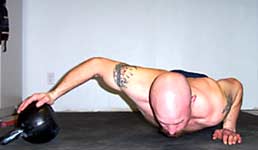 ???
???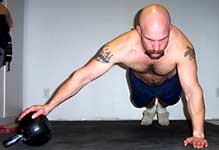
Keep your elbow tucked into your side
so the tricep receives most of the stress.Dive Bomber Pushups: Assume the standard pushup position. Now widen your feet and put your rear in the air. Pretend you are "diving" under a wire, dragging your chest on the ground and press your self up to the front. Your arms should be straight and your back should look very "saggy." Now return the exact same way. If you break it down, on one side you are doing a decline press and the other side an incline press. This is another awesome exercise for shoulder and tricep endurance.
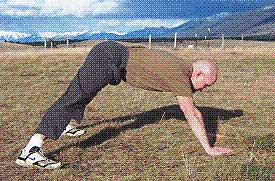
Start position | 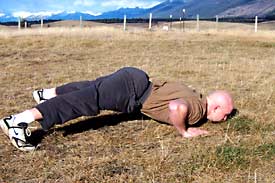
Back arched & going "under the wire" |
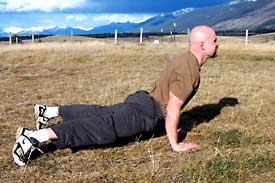
Elbows locked out, repeat in reverse | 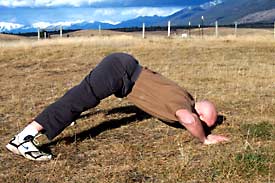
Pressing out to the start position |
Another important weak link is GUTS! It takes a lot of mental fortitude to continually endure the pain of GS training. I find performing on the platform much easier than months of grueling training! Unfortunately, you will have to find your own supply of guts, as I have none to spare.
Jared Savik is the 2004 NAKF Girevoy Sport National Champion. He has authored the e-book American Guide to Girevoy Sport available through his website www.FitnessYouCanUse.com.
Back